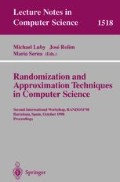Abstract
In this paper we survey the work done for graphs on random geometric models. We present some heuristics for the problem of the Minimal linear arrangement on [0,1]2 and we conclude with a collection of open problems.
This research was partially supported by the ESPRIT LTR Project no. 20244 - ALCOM-IT, CICYT Project TIC97-1475-CE and CIRIT project 1997SGR-00366
Access this chapter
Tax calculation will be finalised at checkout
Purchases are for personal use only
Preview
Unable to display preview. Download preview PDF.
References
F. Avram and D. Bertsimas. The minimum spanning tree constant in geometric probability and under the independent model: A unified approach. The Annals of Applied Probability., 2:113–130, 1992.
F. Avram and D. Bertsimas. On the central limit theorems in geometrical probability. The Annals of Applied Probability., 3:1033–1046, 1993.
M.J. Appel and R.P. Russo. The maximum vertex degree of a graph on uniform points in [0; 1]d. Adv. Applied Probability., 29:567–581, 1997.
M.J. Appel and R.P. Russo. The minimum vertex degree of a graph on uniform points in [0; 1]d. Adv. Applied Probability., 29:582–594, 1997.
N. Alon, J.H. Spencer, and P. Erdös. The probabilistic method. Wiley-Interscience, New York, 1992.
J. Beardwood, J. Halton, and J.M. Hammersley. The shortest path through many points. Proceedings of the Cambridge Philos. Society., 55:299–327, 1959.
B. Bollobas. Random Graphs. Academic Press, London, 1985.
K. Chung. A course in Probability Theory. Academic Press, New York, 1974.
H. Dette and N. Henze. The limit distribution of the largest nearest-neighbour link in the unit d-cube.. Journal Applied Probability., 26:67–80, 1989.
J. Díaz, J. Petit i Silvestre, M. Serna, and P. Spirakis. Heuristics for the MinLA Problem: An Empirical and Theoretical Analysis. Technical Report LSI-98-42-R, Departament de Llenguatges i Sistemes Informàtics, Universitat Politécnica de Catalunya, 1998.
J. Díaz, J. Petit, M. Serna, and L. Trevisan. Approximating layout problems on random sparse graphs. Technical Report LSI 98-44-R, Universitat Politècnica de Catalunya, 1998.
P. Erdos and A. Renyi. On random graphs-i. Publicationes Matematicae, 6:290–297, 1959.
P. Erdos and A. Renyi. On the evolution of random graphs. Publ. Math. Inst. Hungarian Academy of Sciences., 5:17–61, 1960.
A. Frieze and R. Kannan. The regularity lemma and approximation schemes for dense problems. In 37th. FOCS, pages 62–71, 1996.
A Frieze and C. McDiarmid. Algorithmic theory of random graph. Technical report, Department of Mathematics. Carnegie Mellon University., 1996.
J.H. Halton and R. Terada. A fast algorithm for the euclidian traveling-salesman problem, optimal with probability one. SIAM Journal on Computing, 11:28–46, 1982.
R.M. Karp. Probabilistic analysis of partitioning algorithms for the travelling-salesman problem in the plane. Mathematics of Operation Research., 2:209–224, 1977.
G. Mitchison and R. Durbin. Optimal numberings of an n µ n array. SIAM J. on Alg. Disc. Math., 7(4):571–582, 1986.
R. Miles. On the homogeneous planar poisson point process. Mat. Bioscience, 6:85–125, 1970.
D.O. Muradyan and T.E. Piliposjan. Minimal numberings of vertices of a rectangular lattice. Akad. Nauk. Armjan. SRR, 1(70):21–27, 1980. In Russian.
R. Motwani and P. Raghavan. Randomized Algorithms. Cambridge University Press, 1995.
C.H. Papadimitriou. The probabilistic analysis of matching heuristics. In Proc. 15th. Annual Conference on Comm. Control Computing., pages 368–378, 1978.
M. Penrose. The longest edge of the random minimal spanning tree. The Annals of Applied Probability., 7:340–361, 1997.
M. Penrose. On the k-connectivity for a geometric random graph. Technical report, Department of Mathematical Science. University of Durham., 1997.
J. Petit i Silvestre. Approximation Heuristics and Benchmarkings for the MinLA Problem. In R. Battiti and A. Bertossi, editors, Alex’ 98 — Building bridges between theory and applications, 1998.
S. Rao and A. W. Richa. New Approximation Techniques for Some Ordering Problems. In 9th Annual ACM-SIAM Symposium on Discrete Algorithms, pages 211–218, 1998.
M.I. Shamos and D. Hoey. Closest-point problems. In Proc. 16th IEEE Annual Symposium on Foundations of Computer Science, pages 224–233, 1975.
J.M. Steele and L. Tierney. Boundary domination and the distribution of the largest nearest-neighbpr link in higher dimensions. Journal Applied Probability., 23:524–528, 1986.
J.M. Steele. Subadditive euclidean functional and nonlinear growth in geometric probability. Annals of Probability., 9:365–376, 1981.
J.M. Steele. Probabilistic algorithm for the directed traveling salesman problem. Math. od Operation Research., 11:343–350, 1986.
J.M. Steele. Growth rates of euclidean minimal spanning trees with power weighted edges. Annals of Probability., 16:1767–1787, 1988.
J.M. Steele. Probability theory and Combinatorial Optimization. SIAM CBMS-NSF Regional Conference Series in Applied Mathematics., 1997.
B. Weide. Statistical Methods in Algorithmic Design and Analysis. Phd thesis, Department of Computer Science, Carnegie-Mellon University, 1978.
Author information
Authors and Affiliations
Editor information
Editors and Affiliations
Rights and permissions
Copyright information
© 1998 Springer-Verlag Berlin Heidelberg
About this paper
Cite this paper
Díaz, J., Petit, J., Serna, M. (1998). Random Geometric Problems on [0, 1]2 . In: Luby, M., Rolim, J.D.P., Serna, M. (eds) Randomization and Approximation Techniques in Computer Science. RANDOM 1998. Lecture Notes in Computer Science, vol 1518. Springer, Berlin, Heidelberg. https://doi.org/10.1007/3-540-49543-6_23
Download citation
DOI: https://doi.org/10.1007/3-540-49543-6_23
Published:
Publisher Name: Springer, Berlin, Heidelberg
Print ISBN: 978-3-540-65142-0
Online ISBN: 978-3-540-49543-7
eBook Packages: Springer Book Archive

